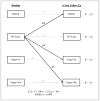Hostility now, depression later? Longitudinal associations among emotional risk factors for coronary artery disease
- PMID: 20407855
- PMCID: PMC2981067
- DOI: 10.1007/s12160-010-9185-5
Hostility now, depression later? Longitudinal associations among emotional risk factors for coronary artery disease
Abstract
Background/purpose: Given that emotional risk factors for coronary artery disease (CAD) tend to cluster within individuals, surprisingly little is known about how these negative emotions might influence one another over time. We examined the longitudinal associations among measures of depressive symptoms and hostility/anger in a cohort of 296 healthy, older adults.
Methods: Participants completed the Beck Depression Inventory-II (BDI-II), Cook-Medley Hostility (Ho) scale, and Anger-In and Anger-Out subscales of the State-Trait Anger Expression Inventory at baseline and 6-year follow-up. We conducted a series of path analyses to evaluate the directionality of the depression-hostility/anger relationship.
Results: Baseline Ho scale was a predictor of 6-year increases in BDI-II (beta = 0.15, p = 0.004), Anger-In (beta = 0.14, p = 0.002), and Anger-Out (beta = 0.11, p = 0.01). In contrast, baseline BDI-II, Anger-In, and Anger-Out did not predict change in any of the emotional variables. Additional path analytic models revealed that the pattern of relationships was not altered after controlling for demographic, biomedical, and behavioral covariates; anxiety symptoms; social support; and subjective sleep quality.
Conclusions: The present results suggest that the cognitive aspects of hostility/anger may precede and independently predict future increases in depressive symptoms but not vice versa. Our findings lead us to speculate that (a) hostility may exert part of its cardiotoxic influence by acting to precipitate and/or maintain symptoms of depression and that (b) the potency of depression interventions designed to improve cardiovascular outcomes might be enhanced by incorporating treatments addressing hostility.
Conflict of interest statement
Figures

Similar articles
-
Association of psychosocial traits with coronary artery calcium development and progression: The Multi-Ethnic Study of Atherosclerosis.J Cardiovasc Comput Tomogr. 2021 Jan-Feb;15(1):56-64. doi: 10.1016/j.jcct.2020.03.004. Epub 2020 Mar 30. J Cardiovasc Comput Tomogr. 2021. PMID: 32280016
-
Negative emotions and 3-year progression of subclinical atherosclerosis.Arch Gen Psychiatry. 2007 Feb;64(2):225-33. doi: 10.1001/archpsyc.64.2.225. Arch Gen Psychiatry. 2007. PMID: 17283290
-
A prospective evaluation of the directionality of the depression-inflammation relationship.Brain Behav Immun. 2009 Oct;23(7):936-44. doi: 10.1016/j.bbi.2009.04.011. Epub 2009 May 4. Brain Behav Immun. 2009. PMID: 19416750 Free PMC article.
-
[A systematic review of psychological distress as a risk factor for recurrent cardiac events in patients with coronary artery disease].J Korean Acad Nurs. 2011 Oct;41(5):704-14. doi: 10.4040/jkan.2011.41.5.704. J Korean Acad Nurs. 2011. PMID: 22143219 Korean.
-
Negative emotion and coronary heart disease. A review.Behav Modif. 2003 Jan;27(1):83-102. doi: 10.1177/0145445502238695. Behav Modif. 2003. PMID: 12587262 Review.
Cited by
-
The relationship between father absence and hostility among Chinese depressed youths: A serial mediation model and the role of self-esteem and frustration tolerance.Front Pediatr. 2023 Jan 26;10:711241. doi: 10.3389/fped.2022.711241. eCollection 2022. Front Pediatr. 2023. PMID: 36776682 Free PMC article.
-
Depressive symptom clusters as predictors of 6-year increases in insulin resistance: data from the Pittsburgh Healthy Heart Project.Psychosom Med. 2014 Jun;76(5):363-9. doi: 10.1097/PSY.0000000000000063. Psychosom Med. 2014. PMID: 24846000 Free PMC article.
-
Associations between protective factors and psychological distress vary by gender: the Buffalo Cardio-Metabolic Occupational Police Stress Study.Int J Emerg Ment Health. 2013;15(4):277-88. Int J Emerg Ment Health. 2013. PMID: 24707590 Free PMC article.
-
Psychological Impact on Firefighters After the 2022 Amok Attack in Berlin at Tauentzienstraße.Healthcare (Basel). 2025 Jan 29;13(3):263. doi: 10.3390/healthcare13030263. Healthcare (Basel). 2025. PMID: 39942452 Free PMC article.
-
Trait anger expression mediates childhood trauma predicting for adulthood anxiety, depressive, and alcohol use disorders.J Affect Disord. 2021 Jun 1;288:114-121. doi: 10.1016/j.jad.2021.03.086. Epub 2021 Apr 3. J Affect Disord. 2021. PMID: 33853004 Free PMC article.
References
-
- Booth-Kewley S, Friedman HS. Psychological predictors of heart disease: A quantitative review. Psychol Bull. 1987;101:343–362. - PubMed
-
- Rugulies R. Depression as a predictor for coronary heart disease. a review and meta-analysis. Am J Prev Med. 2002;23:51–61. - PubMed
-
- Wulsin LR, Singal BM. Do depressive symptoms increase the risk for the onset of coronary disease? A systematic quantitative review. Psychosom Med. 2003;65:201–210. - PubMed
-
- van Melle JP, de Jonge P, Spijkerman TA, et al. Prognostic association of depression following myocardial infarction with mortality and cardiovascular events: a meta-analysis. Psychosom Med. 2004;66:814–822. - PubMed
-
- Chida Y, Steptoe A. The association of anger and hostility with future coronary heart disease: a meta-analytic review of prospective evidence. J Am Coll Cardiol. 2009;53:936–946. - PubMed
Publication types
MeSH terms
Grants and funding
LinkOut - more resources
Full Text Sources
Medical
Miscellaneous

